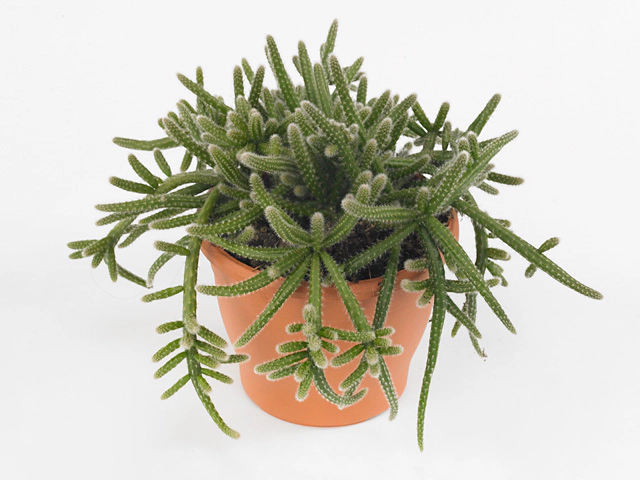Rhipsalis baccifera subsp. horrida

| Plant height | 5 - 10 cm |
| Structure (tissues) | Succulent |
| Plant, growth type | Pendulous |
The Rhipsalis baccifera subsp. horrida, commonly known as the Mistletoe Cactus, is a fascinating and unique plant that belongs to the cactus family. It is known for its pendulous growth type, which means it hangs downwards, creating a stunning natural display. With a compact size ranging between 5 to 10 centimeters in height, this succulent plant is ideal for those with limited space or for those looking to add some greenery to their hanging gardens.
One of the most impressive features of the Mistletoe Cactus is its succulent structure. Its tissues are thick and fleshy, allowing the plant to store water efficiently, making it resilient to drought conditions. This adaptation is vital for its survival in its natural habitat, where it often grows as an epiphyte, attaching itself to tree branches and rocks.
The pendulous growth of the Mistletoe Cactus gives it an enchanting appearance, resembling a cascading plant curtain. Its long, slender stems hang from a central point, gracefully swaying in the air. This unique growth habit makes it a popular choice among plant enthusiasts, as it can be showcased in hanging baskets or mounted on walls, adding a touch of elegance and charm to any space.
To cultivate a Mistletoe Cactus, it is important to provide the plant with the right conditions. This cactus thrives in bright, indirect light, making it suitable for indoor spaces near windows or on balconies with partial shade. It is important to protect the plant from intense sunlight, as it may cause damage or discoloration to the leaves.
In terms of care, the Mistletoe Cactus is a relatively low-maintenance plant. As a succulent, it requires well-draining soil to prevent root rot. Regular watering is necessary, but it is essential to allow the soil to dry out between watering sessions to prevent overwatering. During the growing season, from spring to fall, the plant may benefit from a diluted, balanced fertilizer to promote healthy growth.
Propagating the Mistletoe Cactus is relatively simple. Stem cuttings can be taken from the mother plant and left to dry for a few days before placing them in a well-draining potting mix. With proper care, these cuttings will develop roots and establish new plants.
In conclusion, the Rhipsalis baccifera subsp. horrida, or Mistletoe Cactus, with its pendulous growth type and succulent structure, is a captivating addition to any plant collection. Its compact size and ability to thrive in various light conditions make it suitable even for small spaces. With minimal care requirements and its ability to propagate easily, this delightful cactus is a must-have for any plant enthusiast looking to add a touch of elegance to their surroundings.
Market availability index by month:
| Jan. | Feb. | Mar. | Apr. | May | Jun. | Jul. | Aug. | Sep. | Oct. | Nov. | Dec. |
|---|---|---|---|---|---|---|---|---|---|---|---|
| 4 | 3 | 3 | 3 | 3 | 3 | 3 | 3 | 3 | 3 | 3 | 3 |